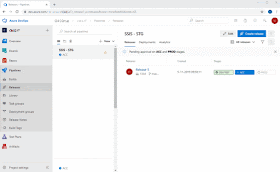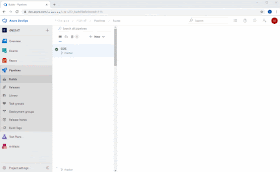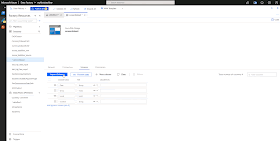Until now we needed Third Party tasks or PowerShell to deploy an SSIS project in DevOps. Now Microsoft finally released its own SSIS DevOps tasks. How does it work?
 |
| Replace PowerShell code with Microsoft SSIS Deploy task |
Solution
Microsoft just released the SSIS Deploy task (public preview) which makes it much easier to deploy an SSIS project. Below you will find the codeless steps to deploy artifacts created by the SSIS Build task.
1) New Release Pipeline - Empty Job
The first step is to create a new Release Pipeline. For this example we will use an empty job to start with and later on add tasks manually.
- Go to the Pipelines menu on the left
- Go to Releases
- Click on + New to create a New Release pipeline
- Next choose 'Empty job'
Next step is to give the first Stage its name. A Stage is an environment like acceptance or production where you want to deploy your SSIS packages. For this example we will have three stages / environments: Dev/Tst, Acc and Prd. The next two stages will be created by using cloning, but first we will add and configure the new deploy task so that you don't have to repeat yourself.
- After choosing 'Empty job' a first stage is created. Rename it 'DEV/TST'
- Close the Stage pane by clicking the cross in the upper right corner
 |
| Create Relesae Pipeline |
2) Select Artifact
In the Artifact pane you need to select the Artifact (the ispac file) that you created in the Build Pipeline. So look up the name before you start.
- In the Artifacts pane click on + Add to add an artifact
- Choose the project if you have multiple DevOps projects
- Select the Artifact of the CI pipeline
- Select Latest version
- Optionally rename the source alias
- Click on the Add button
We also need to determine whether we want to use the Continuous deployment trigger or perhaps use an other trigger or scheduling. For this example we will use the CD trigger.
- Click on the lightning icon
- Enable Build trigger (to release after each new successful build)
- Close the CD trigger pane by clicking the cross in the upper right corner
 |
| Add Artifact and enable Continuous deployment |
3) Add variables
For this example we need three variables: SsisServer, SsisDBUsername and SsisDBPassword
- Go to the Variables tab
- Click on the + Add to add the first variable
- Enter the name of the variable
- Enter the value of the variable
- Hit the padlock icon when it's a sensitive value like a password
- Select the first stage 'Dev/Tst' as scope
Repeat this for all three variables and later on, after the next step, repeat this for each Stage. For each stage it will add the same three variable, but with a different scope (Acc or Prd), but you do have to change the values of the variables.
 |
| Add variables to DevOps |
4) Add task to first stage
Now we need to add a task to do the actual deployment of the SSIS ispac file. This is where the new Microsoft SSIS Deploy DevOps task is used. Note: Click on the Info-icon behind each field title to get more information about the desired value for that field.
- Within the first Stage pane, click on the '1 job, 0 task' link to go to the job
- Optionally change the settings of the Agent job (for example its name)
- Click on the + icon in the Agent Job to add a new task
- Search for 'SSIS Deploy'
- Add the task called SSIS Deploy (This is the official Deploy Task for SSIS DevOps from Microsoft). Note: There are various third party tasks with the same name.
- Click on the new task and rename it to Deploy SSIS [projectname]
- Use the ellipsis button to browse to the ISPAC file
- Use SSISDB as Destination Type
- Use $(DBServer) as Destination Server (this retrieves the value of the variable)
- Use "/SSISDB/[projectname]" as Destination Path (replace it with the foldername you need)
- Use SQL Server Authentication as Authentication type
- Use $(DBUsername) as Username (this retrieves the value of the variable)
- Use $(DBPassword) as Password (this retrieves the value of the variable)
- Leave Overwrite on (you want to do this more often)
 |
| Add SSIS Deploy task to Release pipeline |
5) Add stages
Now we need to clone the Dev/Tst stage to Acc and to Prd.
- Click on the Pipeline tab if you don't see your first Stage
- Hover above the first stage and wait for the clone button to appear and click it
- Next rename it to Acc
- Repeat this for Prd
Notice the red exclamation mark before the variables tab after adding a stage: you need to add the same variables for each stage
 |
| Adding stages for Acc and Prd |
For each Stage you can determine how that Stage starts. These are the 'Pre-deployment conditions'. For example for Dev/Tst you could do an automatic deployment, for Acc you first need an approval from one person and for Prd you need two approvals.
- Click on the lightning/person icon on the left side of each Stage to set it
- Dev/Tst will use the 'After release' trigger and the next stages will use the 'After stage trigger'
- For Acc and Prd you could add Pre-deployment approvals by selecting one of your teammembers.
- Close the Pre-deployment conditions pane by clicking the cross in the upper right corner
- Repeat this for all stages
And don't forget to add the variables when you have finished the Pre-deployment settings.
 |
| Adding Pre-deployment conditions for each stage |
6) Test
Now create a new release by activating the build task. After this a new artifact will be created and this will trigger the release pipeline. You can also hit the Create Release button in the upper right corner to use the last created artifact. The artifact will automatically be released to the first stage, but the next step waits for approval (click on the blue ACC button to approve).
 |
| Dev/Tst succesful, Acc waiting for approval |
Note: You can also check the result of the release by clicking on stage DEV/TST and then click on the SSIS Deployment step. If it failed you can see the error messages per step.
Conclusion
In this post you saw how easy it is to deploy an SSIS project to the Integration Services Catalog with this new task. It is easy to switch between various Authentication types. One small disadvantage is that you don't have any options for the SSIS Catalog Environments. You either have to do that manually or you have to write some PowerShell or TSQL code to do that after the deployment.





















































